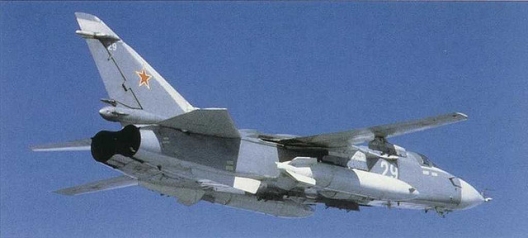 Russia’s Air Force is falling from the sky.
Russia’s Air Force is falling from the sky.
As the Kremlin continues to assert its air power in a bid to intimidate NATO allies in Europe and North America, its mostly Soviet-built aircraft are being pushed to their limits — a fact experts point to when attempting to explain the loss of five aircraft of different designs in just the past month.
The latest in the string of crashes came July 6, when a two-seat Su-24 strike fighter crashed at an air base outside of Khabarovsk, in Russia’s Far East, while trying to take off for a training exercise.
This follows the crashes of two MiG-29s, an Su-34 and a Tu-95, all in the last month — part of a larger trend of Russian aviation failures over the last several years as the Soviet-era fleets have fallen victim to age and substandard sustainment.
A source close to the Defense Ministry said on condition of anonymity that the crashes are the result of two key trends dogging Russia’s Air Force today — the overuse of old aircraft and a lack of qualified pilots.
It is easy to understand the first point. The pace of Russian activities has shot up dramatically since its invasion of Ukrainian territory in March of 2014.
According to data provided by NATO, the alliance intercepted over 400 Russian aircraft near its airspace in 2014 following the start of the Ukraine Crisis, a 50 percent increase over the previous years and a rate that harkens back to the antagonistic posturing of the Cold War.
Another issue the Russian source identified is the lack of qualified pilots to fly the kinds of missions the Defense Ministry is asking of the Air Force as Moscow tries to flex its muscles in the face of NATO.
“There are less pilots [in Russia] than there are aircraft, and they gave young pilots missions that are supposed to be given to experienced pilots,” the source said.
These young pilots are lacking in basic skills such as midair refueling, the source said, noting “today, air refueling in Russia is, I dare to say, almost something exceptional….”
Shortly after the crash of the Su-24 on July 6, the head of Russia’s Air Force, Col. Gen. Viktor Bondarev, ordered the grounding of all Su-24 planes until the cause of the crash is identified — making the fleet Russia’s third to be grounded over the last month.
On July 3, Russia’s force of over 200 MiG-29 air superiority fighters were grounded after one crashed near its base in Krasnodar in southern Russia — the fourth loss of a MiG-29 over the past year….
The Russian Air Force was also forced to ground its fleet of 61 Tu-95 “Bear” long-range strategic bombers temporarily last month after an engine fire during takeoff led one to run off its runway during takeoff from the Ukrainka Air Base in Russia’s Far East….
There is, for example, a production bottleneck in engines for the Tu-95s. Russia can only produce about 10 Bear engines a year for a fleet of over 60 of the four-engined airplanes.
After last month’s incident with the Bear at Ukrainka Airbase, it is not clear how long the bombers were grounded, or if it impacted the rate of Russia’s provocative patrols near NATO borders.
However, two Tu-95s were intercepted by US Air Force F-22 aircraft off the California coast on July 4.
Image: Russian Su-24, Sept. 26, 2009 (photo: AereiMilitari.org)
